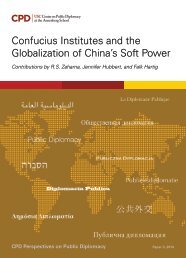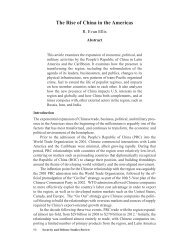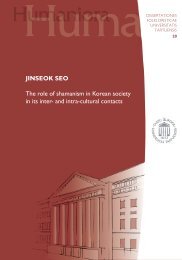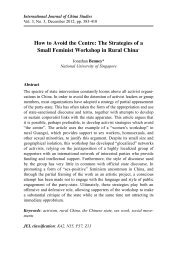JennyChan.PhDThesis.2014.FINAL
JennyChan.PhDThesis.2014.FINAL
JennyChan.PhDThesis.2014.FINAL
Create successful ePaper yourself
Turn your PDF publications into a flip-book with our unique Google optimized e-Paper software.
educed or eliminated, state-owned enterprises are responsible for their profits and<br />
losses with the pressures passed on to workers. William Hurst sharply observes that,<br />
during the 1990s through the early 2000s, “state firms became more, rather than less,<br />
politicized through reform.” 117 Local government officials, including trade unions<br />
and women’s federations, advise laid-off workers to learn from entrepreneurial<br />
migrant workers to find new opportunities. They define the problem as personal, as a<br />
question of whether the individual worker is lazy, or is taking initiative to adapt to<br />
market changes and to advance with the times. 118<br />
Neoliberals believe that “human well-being can best be advanced by liberating<br />
individual entrepreneurial freedoms and skills within an institutional framework<br />
characterized by strong private property rights, free markets, and free trade.” 119<br />
China well illustrates the stark reality that follows from this logic: increased income<br />
polarization and structural inequality based on class, exacerbated by state withdrawal<br />
from the lifetime employment and welfare protection of workers in state-owned<br />
enterprises and collective firms. 120<br />
Meanwhile, with the influx of foreign direct investment and the relaxation of state<br />
restrictions on rural-to-urban migration since the 1980s, successive cohorts of<br />
internal migrant workers have simultaneously become the core of the new industrial<br />
working class and been exposed to market risks and uncertainty. With China’s<br />
emerging state capitalism, labor flexibility, production efficiency, and competition<br />
across enterprises with various forms of ownership and labor relations become<br />
imperative. 121 Yet even as class contradictions sharpen across society, the language<br />
of class has largely disappeared from Chinese discourse. As Ching Kwan Lee and<br />
Yuan Shen demonstrate, under dual pressure from the state and academic institutions,<br />
many scholars who study workers in post-socialist China “shun class analysis and<br />
Labour Politics in China,” Global Labour Journal 1(1), pp. 92-111.<br />
http://digitalcommons.mcmaster.ca/cgi/viewcontent.cgi?article=1025&context=globallabour<br />
117 William Hurst, 2009, The Chinese Worker after Socialism, Cambridge, UK: Cambridge University<br />
Press, p. 53.<br />
118 On workers’ acceptance of the hegemony of the market and their search for a market-based<br />
solution to maximize individual gains, willingly or otherwise, see Marc J. Blecher, 2002, “Hegemony<br />
and Workers’ Politics in China,” The China Quarterly 170, pp. 283-303.<br />
119 David Harvey, 2005, A Brief History of eoliberalism, Oxford: Oxford University Press, p. 2.<br />
120 Dorothy J. Solinger, 2009, States’ Gains, Labor’s Losses: China, France, and Mexico Choose<br />
Global Liaisons, 1980-2000, Ithaca, NY: Cornell University Press; Yin-wah Chu and Alvin Y. So,<br />
2010, “State Neoliberalism: The Chinese Road to Capitalism,” Chinese Capitalisms: Historical<br />
Emergence and Political Implications, edited by Yin-wah Chu, Basingstoke: Palgrave Macmillan, pp.<br />
46-72.<br />
121 Joel Andreas, 2012, “Industrial Restructuring and Class Transformation in China,” China’s<br />
Peasants and Workers: Changing Class Identities, edited by Beatriz Carrillo and David S. G.<br />
Goodman, Cheltenham, UK: Edward Elgar, pp. 102-23.<br />
32






